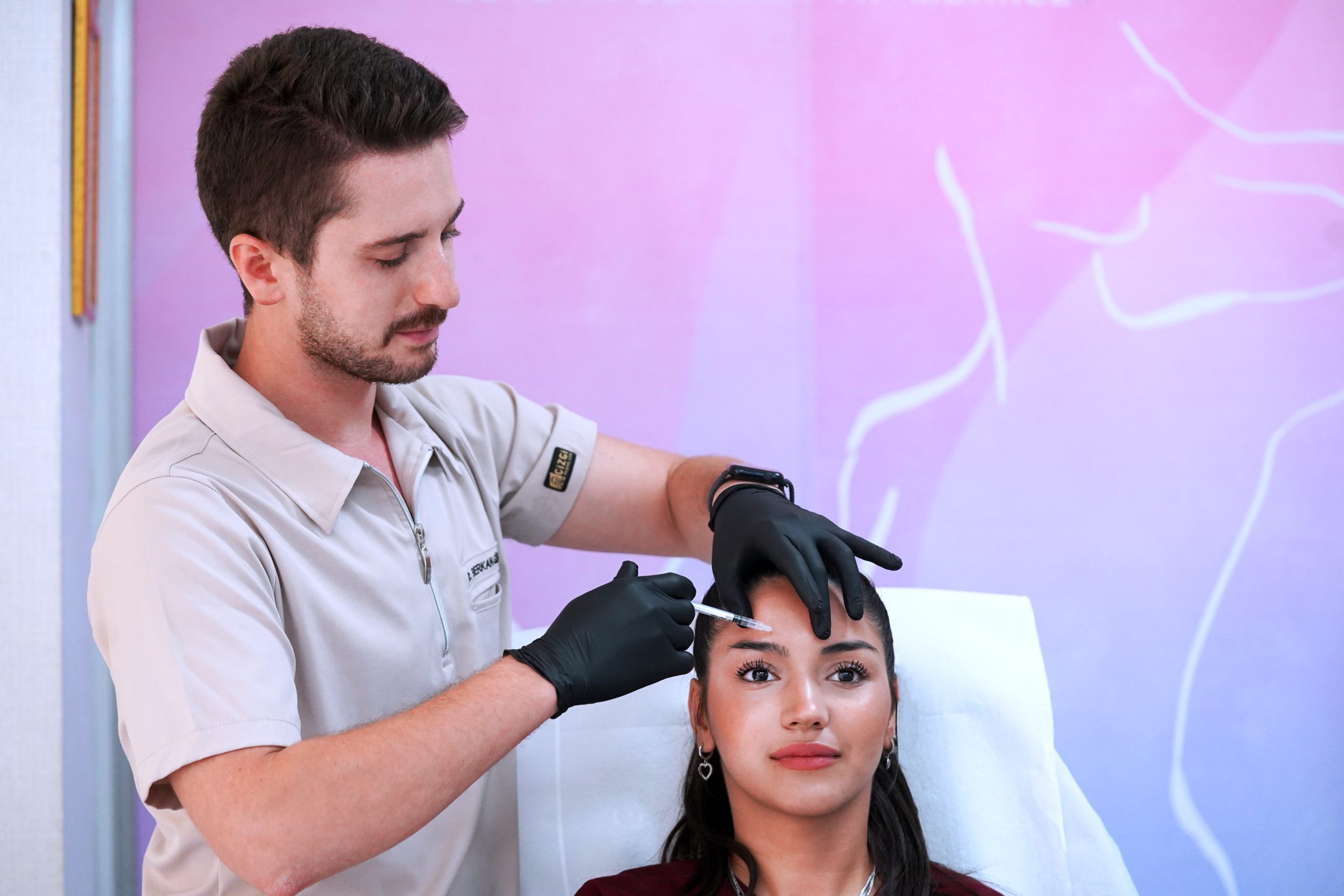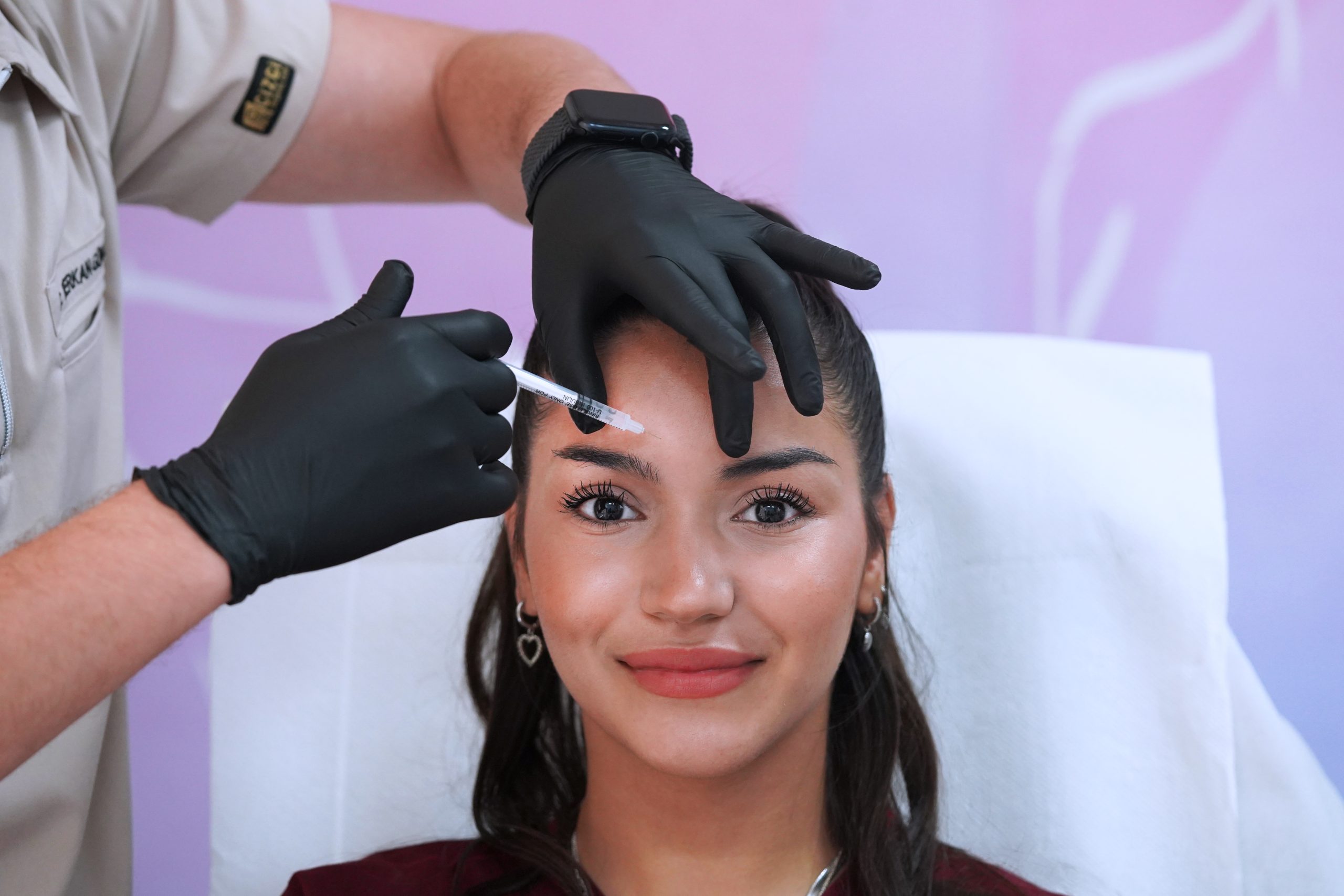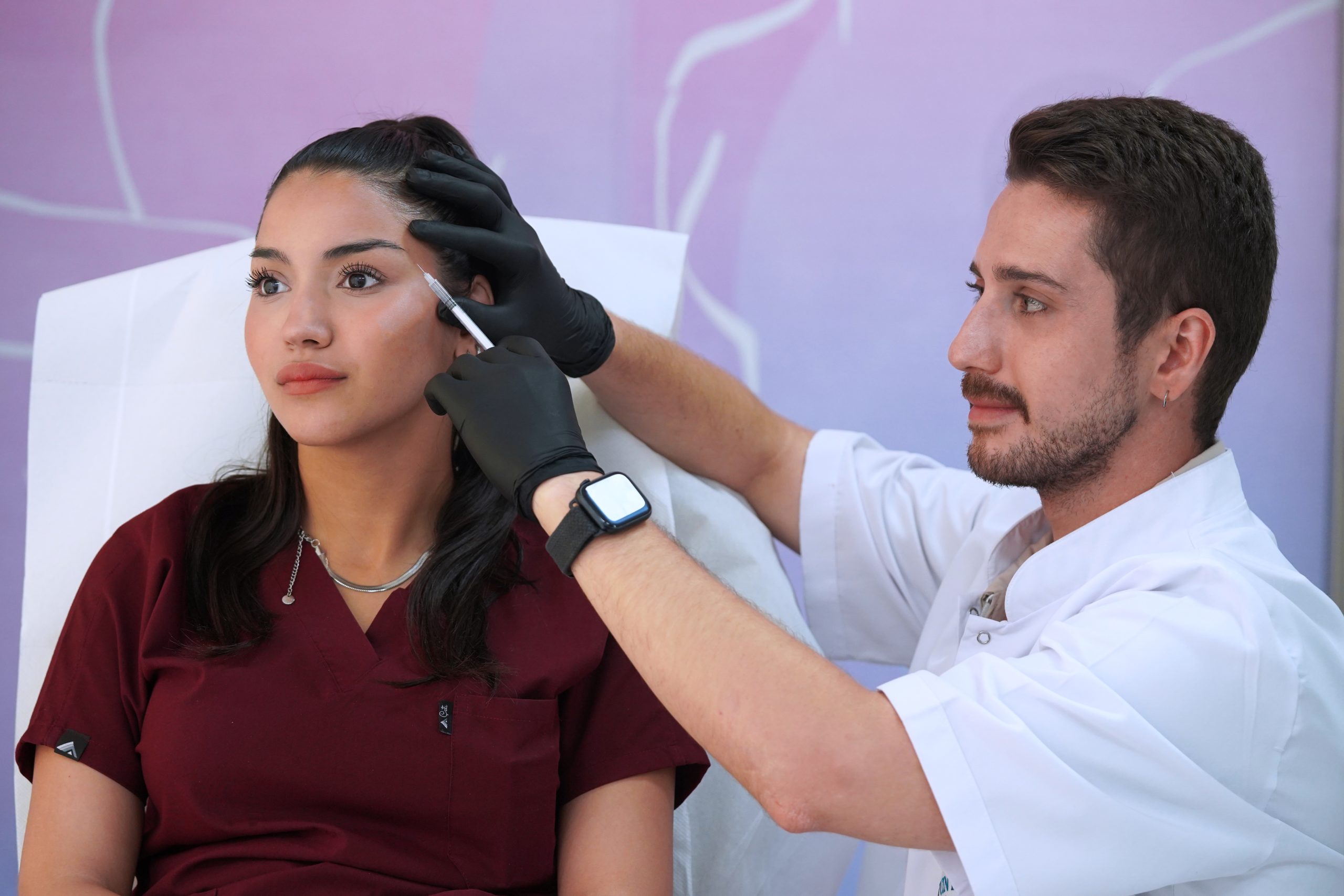What are Forehead Lines? Why Does It Occur?
 These wrinkles are called glabellar lines or forehead lines. Glabellar lines are horizontal indentations that extend across the forehead.
These wrinkles are called glabellar lines or forehead lines. Glabellar lines are horizontal indentations that extend across the forehead.

Can Forehead Lines Be Prevented?
Since it is not possible to completely eliminate the effects of aging, it may be difficult to completely get rid of forehead lines. However, some precautions can be taken to make forehead lines less noticeable. The most effective way to slow down aging and prevent forehead lines is to adopt a healthy lifestyle.
A healthy and balanced diet, avoiding exposure to sunlight, exercising regularly and managing stress are considered the most effective methods to keep both the skin and the rest of the body healthy. It is stated that certain precautions can be taken to delay the formation of forehead lines rather than preventing them.
Before forehead lines become too deep, non-surgical applications such as mesotherapy and facial rejuvenation procedures may be beneficial choices.
Who Should Have a Forehead Lift?
Forehead lift surgery is generally performed on people over the age of 40. However, due to structural or genetic factors, it may sometimes be possible to perform forehead lift surgery at an earlier age.
People with deep lines in the forehead area and drooping in the temple area and eyebrows may be suitable candidates for forehead lift aesthetics. In addition, the person must be in good general health and have no condition that would prevent surgery.
Are Temple Lifts and Forehead Lifts the Same?
Temporal lift, in other words forehead lift, are actually procedures performed for the same purpose but referred to by different names. Forehead lift and temple lift are procedures performed to give the area above the eyes a younger, more refreshed appearance. The position of sagging eyebrows is corrected, and lines that may cause the person to have a sad or tired appearance are improved.
For this purpose, the muscles or tissues that cause lines and sagging in the forehead area are intervened in order to soften the forehead, lift the eyebrows and minimize frown lines.
By Which Methods Is Forehead Lift Aesthetics Performed?
Forehead lift aesthetics can be performed by both surgical and non-surgical methods. Injections, fillers, mesotherapy and other medical aesthetic procedures can be applied for forehead lift. Surgical methods are classical forehead lift surgery and endoscopic forehead lift surgery.
How is Forehead Lift Plastic Surgery Performed?
As a result of the evaluations made specifically for the patient who will undergo forehead lift aesthetics, the plastic surgeon determines which approach will be more effective in achieving the patient’s cosmetic goals. Accordingly, classical forehead lift or endoscopic forehead lift method can be applied.
In the classic forehead lift method, the hair is taped to both sides of the incision line with rubber bands before starting the operation. In this method
Although the hair does not need to be shaved, the hair growing directly above the incision line may need to be cut.
A coronal incision is usually used. The coronal incision, which starts at ear level, creates a headphone-like appearance going down the other side of the head. Since the incision is usually made well behind the hairline, there is no visible scar. If the hairline is high or there is balding in the forehead area due to receding hairline, the incision can be placed immediately at the hairline to prevent the forehead from appearing lighter.
For this reason, people with hair loss or baldness may sometimes be recommended a mid-scalp incision that follows the natural structure of the skull bones. For people suffering from baldness or hair loss, the incision made in the middle of the scalp is less noticeable as it follows the natural composition of the two bones in the skull.
When the hair covers the forehead, most such scars become less noticeable. In male patients whose hair styles are not suitable for covering incision scars, special planning may be required to hide the scar.
After the incision, the forehead skin is carefully lifted. Thus, the underlying tissue can be removed and the forehead muscles that cause lines in the forehead area and eyebrows falling downward can be destroyed. A smoother and younger appearance can be achieved by lifting the eyebrows and trimming the excess skin. The incision is then closed with stitches or clips.
The endoscopic forehead lift method typically requires the same preparation steps as the traditional forehead lift method. The difference of this method is that no long coronal incision is made. Instead, a small incision is made on the right temple, left temple, upper left and upper right parts of the forehead. The endoscope, a pen-like camera attached to a monitor, is inserted into one of the incisions. In this way, the surgeon can see the muscles and tissues under the skin very clearly.
The forehead skin is lifted with another instrument inserted through a different incision. To obtain a smooth appearance, muscles and underlying tissues are removed or necessary changes are made. In the meantime, the muscles can be lifted with stitches under the skin surface or with temporary fixation screws placed behind the hairline. And it can be fixed to its higher positions. After these procedures are completed, the incisions are closed and the operation is completed.
Which is the Best Method?
Unfortunately, it is not possible to give a clear answer to this question. The best method is actually the method that is most suitable for the patient. Therefore, after evaluating the patient’s general health condition, needs and expectations, it should be decided which method should be applied in the light of this information.
What is Endoscopic Forehead Lift?
Endoscopic forehead lift is a procedure performed through small incisions made at the temples, above the forehead, and behind the hairline. Through these incisions, an endoscope is passed between the skull and forehead skin. The eyebrow is lifted with precision instruments used.
As a result of fixing it to the skull, a natural eyebrow height is achieved both vertically and laterally. In cases where people only need a lateral brow lift, temporal brow lift, that is, temple lift, can be performed.
Can Wide Foreheads Be Performed Together with Reduction Surgery?
A person’s hairline starting further back than where it should be or hair loss occurring where the hairline begins may cause a wider forehead appearance. Of course, genetic factors can also cause people to have a wider forehead than normal. Wide forehead reduction can be done using different methods.
Advantages of Temple Lift Surgery
As a result of temple lift surgery, a firm and youthful appearance is achieved. With this surgery, in which the eyebrows are lifted up and the lines and wrinkles in the forehead and between the eyebrows are eliminated, it is possible to eliminate the deformations that occur due to aging. Thus, the tired and unhappy expression on the person’s face is replaced by a lively and vigorous appearance. But the natural aging process cannot be prevented.
Advantages of the Classic Forehead Lift Method
In this method, the entire forehead area, along with the underlying muscles and tissue, is manually lifted and excess skin is removed. In this way, not only the eyebrow area is pulled up and the forehead area is also flattened. The classical forehead lift method is very effective as some skin needs to be removed from the forehead in older patients where the forehead lines have deepened and the abundance of skin has become very noticeable.
By lifting the muscles and tissue and removing excess skin, forehead lines are smoothed and sagging is eliminated. Thus, a youthful appearance is achieved.

Disadvantages of the Classic Forehead Lift Method
In order to perform the classical forehead lift method, a long incision must be made in the area of the scalp. Under normal conditions, the incision scar is not visible to the naked eye as it is hidden in the scalp. However, if there is hair loss in the application area after the classic forehead lift surgery performed on men, the surgery scar may become visible.
Return to Normal Life
Even if patients stand up within a day or two after the operation, they should spend at least a week to rest. It is possible to shampoo and wash the hair as soon as the bandages are removed, and in some cases, two days after the operation. Generally, you can return to work and social life within 7-10 days. This period may be slightly shorter in people who have had an endoscopic forehead lift surgery.
According to the doctor’s advice, jogging, heavy exercise, sexual intercourse or activities that may increase blood pressure should generally be restricted for a few weeks. Care should be taken to avoid prolonged exposure to heat or sunlight for several months.
Healing Process
The recovery process of patients who have undergone classical forehead lift surgery and patients who have had endoscopic forehead lift surgery may develop differently. Patients using the classical forehead lift method may experience some numbness and temporary discomfort around the incision.
This is a condition that can be resolved with medications prescribed by the doctor. As a protective measure in patients prone to headaches, longer-acting local anesthesia may be used during surgery.
The head should be kept elevated for two or three days after the surgery to reduce swelling that may occur after the operation. Swelling may occur, affecting the cheeks and eyes. However, this situation resolves itself within a week.
With the recovery of the nerves, the numbness on the upper part of the scalp may be replaced by itching. It may take up to six months for these feelings to disappear completely, although it varies from patient to patient. Some of the hair around the incision may be lost or temporarily thinned. Normal hair growth usually resumes within a few weeks.
Patients using the endoscopic forehead lift method may experience some numbness, discomfort at the incision site, and slight swelling. Incision site pain is generally minimal and can be controlled with painkillers when necessary.
The itching sensation is generally less in patients using the endoscopic forehead lift method. Visible symptoms after forehead lift surgery disappear completely within approximately three weeks.

Are There Non-Surgical Methods?
If they are suitable for people who want to have a forehead lift, it is possible to apply medical procedures and get results without a surgical procedure. Injection is the primary medical aesthetic procedure used for forehead lift. The injection eliminates lines between the eyebrows and lifts the eyebrows.
The injection relaxes the muscles, making the skin smoother and eliminating the lines between the eyebrows. Additional injections may also be given to the tips of the eyebrows to help the muscles relax. Thus, the forehead muscles lift this area up.
The effect achieved varies depending on age and the strength of the muscles that remain active to lift the relaxed muscles. The injection allows the removal of stubborn eyebrow lines and deep wrinkles between the eyebrows without surgery.
Another treatment used for forehead lift is the filling method. Hyaluronic acid is injected into the area where forehead lines are located under local anesthesia. Hyaluronic acid or fat obtained from the person’s own body can be used directly into the wrinkles by injection with very fine-tipped needles. In this way, it is possible to obtain a smooth appearance in the area. Fractional laser, ultherapy and thread forehead lift can also be counted among non-surgical forehead lift methods.
It is very important to correctly determine the areas to be intervened in the thread forehead lift method and the type of medical thread to be used. After determining the areas where the treatment will be applied, tiny needles are placed and threads are placed under the skin along the forehead. Once the threads are placed, the needles are removed.
Thanks to the placed threads, the skin in the forehead area gains elasticity and is restructured. This method, which aims to reproduce the collagen that the skin cannot produce due to aging, stands out as a very effective and scar-free procedure.
Temple Stretching with Injection
Injection is one of the non-surgical methods used in temple lifting. Wrinkles and sagging formations in both the forehead and upper face can be eliminated by injection. In this way, it may be possible to eliminate the lines that occur due to the effect of gravity and the disturbed balances of tissues and muscles.
During the injection, which is completed in a short time and is painless, the lines and dimples that are not very deep begin to heal themselves at the end of the application. Eyebrows are made to look higher.
Since injection is a process that remains permanent for a certain period of time, it should be repeated at regular intervals. As a result, it is possible to maintain the permanence of the raised appearance of the eyebrows with the smooth wrinkle-free appearance obtained in the forehead and temple areas.
How are Temple Lift Surgery Prices Determined?
Temple lift surgery prices are determined according to the needs of the patient, the scope of the treatment to be applied, the operating technique to be used, the type of anesthesia to be applied, the surgeon’s experience, the hospital’s pricing policy and some factors such as these.
Therefore, it is not possible to give fixed price information. It would be much healthier to provide pricing information after the person who wants to have temple lift surgery is examined.
Which Surgeries Can Be Combined with Forehead Lift Aesthetics?
Forehead lift aesthetics is often combined with eyebrow lift, face lift or blepharoplasty, that is, eyelid aesthetics. It is common to combine it with blepharoplasty, especially if there is significant skin sagging in the upper eyelids. However, it may be possible that the sagging of the upper eyelids of some patients can be resolved only with forehead lift aesthetics. Forehead lift aesthetics can also be combined with other facial aesthetic operations other than blepharoplasty.
Is Endoscopic Temple Stretching Performed?
Forehead lift and temple lift surgeries are aesthetic surgeries performed to eliminate deepened lines and wrinkles on the forehead and to lift downward eyebrows.
In cases where there is a need to remove excess skin in the temple area, the endoscopic temple lift method can be applied if the amount of skin to be removed is not too much. Thus, it is possible to complete the surgery with 4 or 5 small incisions instead of one full-length incision.
What are the advantages of Endoscopic Temple Lift Surgery?
In endoscopic temple lift surgery, which can be completed in a short time, complications are fewer and incision scars are much smaller. The incision scars, which are invisible to the naked eye, are an important advantage in terms of not leaving any scars after the operation.
In addition, the recovery time in endoscopic temple lift surgery is much shorter than in classical forehead lift surgery. What is important at this point is that the operation is performed on selected patients, that is, those whose cosmetic concerns can be resolved with endoscopic temple lift.
Is Forehead Stretching Performed with Thread?
Yes, thread forehead lift is an effective skin tightening method performed under local anesthesia. Medical threads are placed under the skin with the help of fine-tipped needles. Threads basically aim to encourage the regeneration of collagen, whose production decreases due to aging.
With the application of the method, the skin and subcutaneous tissues are restructured and the threads placed in the problematic areas create the effect of a lift. So they create a reaction. They begin to produce biological fibroblasts, elastin and collagen.
Smoking After Forehead Lift
As after all surgical operations, smoking is not recommended after forehead lift surgery, at least for the period determined by the doctor. Smoking can cause the healing process to take longer due to its ability to delay the healing of wounds. It is also known that smokers are at greater risk of major complications, which, although rare, may occur during and after the operation.
Bath After Forehead Lift
Under normal circumstances, bathing can be done starting from the second day after the surgery. However, since the process may differ from person to person, the doctor’s instructions should be followed.
Temple Lift Frequently Asked Questions
However, removing lines and wrinkles on the forehead and lifting the eyebrows will give the face a more vibrant and youthful expression. Therefore, it can be understood that you have had a forehead lift due to the positive change in your appearance.
Meet Our Doctors
Table of ContentsToggle Table of ContentToggle
- What are Forehead Lines? Why Does It Occur?
- Can Forehead Lines Be Prevented?
- Who Should Have a Forehead Lift?
- How is Forehead Lift Plastic Surgery Performed?
- Advantages of Temple Lift Surgery
- Advantages of the Classic Forehead Lift Method
- Disadvantages of the Classic Forehead Lift Method
- Return to Normal Life
- Healing Process
- Are There Non-Surgical Methods?
- Temple Stretching with Injection
- How are Temple Lift Surgery Prices Determined?
- Which Surgeries Can Be Combined with Forehead Lift Aesthetics?
- Is Endoscopic Temple Stretching Performed?
- What are the advantages of Endoscopic Temple Lift Surgery?
- Is Forehead Stretching Performed with Thread?
- Smoking After Forehead Lift
- Bath After Forehead Lift
Call Me Back

